Here we present selected parts of the paper titled “Mycenaean Technology“, by T.P. Tassios, taken from the impressive collective work “Science and Technology in Homeric Epics“, edited by S.A. Paipetis (Springer, 2008).

“It is interesting to revisit the Iliad and the Odyssey, searching for technical stories – although very briefly.
(a) Metals: Besides gold and silver, bronze (copper + tin) was the basic metallic material in Iliad (Il. 15.309). Iron will furiously invade Odyssey – in the form of quenched steel as well (e.g. Od. 9.391). Metal workshops are vividly described (Il. 18.412, Od. 8.274).
Weapons: The significance of this basic subject of fabrication of weapons is shown by the fact that almost the entire rhapsody 18 is devoted to this technology. Besides, weaponry is a frequent subject of Homeric Epics: Arrows (Il. 4.105), shields (Il. 15.308), cuirasses (Il. 8.195), chariots (Il. 5.722) – and above all, the famous weapons of Achilles (Il. 18.144).
(b) Buildings: It is worth noting that in Iliad, mainly the rich and complex palaces of gods are described (e.g. Il. 1.607, 5.167, 18.371 etc), whereas in Odyssey, building technology is landed on earth, describing human buildings (e.g. Od. 4.72). In the house (and ship) building technology, it is interesting to include also the structural miracle of the Wooden Horse (Od. 4.272, 8.493, 11.24) – that complex and solid artifact of chief-carpenter Epeios: A giant mobile work, with a body measuring something like 8 by 16 by 32 meters (inorder to be able to accommodate three thousand well hidden hoplites, as it is said).
(c) Automats: Here we find ourselves in the summit of ancient Greeks’ technophilia.
Such is their confidence of their technical knowledge, that they rush to the future of
• Moving automats: self moving tripods, entering and leaving the Palaces (Il. 18.376), automatic bellows of metallurgical kilns (Il. 18.468), gates automatically opening when hearing a whip (Il. 5.749). This is an Epic of Technology
• Animal and human-like automats: guardian dogs (made of gold and silver, Od. 7.91), live girls-robots (“in them is mind and wits, in them too a voice and strength”, Il. 18.418), etc.
• Traps: elaborated grips, hidden above and underneath the bed, in order to catch the illegal lovers (Od. 8.274).
• Automat ships: the ships of the inhabitants of Scheria exceed the achievements of modern Automat Technology – they are “διανoούμενα” (intelligent) ships: They have no captains, but they conceive “what men have in mind”, and they travel them very rapidly across the clouds – and they are unsinkable (Od. 8.562). It is the first time that the techno-mythical thought of the Greeks dares to figure out human robotic achievements, whereas up to that moment automats were thought only in the service of gods*.
(d) Artifacts-artistic objects: in fact, the gods had initially taught humans the technical skill and crafts*; Hephaestus himself “ετεϕάνη”(was manifested) to humans and lived nine years with them (see Homeric Hymn to Hephaestus, 20.3), whereas, later on, Prometheus (Plato, Protagoras, 321c) will take Technology from Athena and Hephaestus, he will transfer it to humans, and thus will save mankind.
The Technology of Mycenaeans
Archaeological findings, throughout Greece and in numerous areas of Mediterranean Sea (from Syria to Sardenia), have confirmed a good part of the alleged technophilia of the Achaeans, i.e. the Mycenaean world. During the second half of the 2nd Millennium BCE, Mycenaean people have developed an advanced Technology, many centuries before the classical and Hellenistic times, which seem to be better studied from this point of view.
Water Supply of Cities
First, I will briefly describe the underground well-houses, following the views of Knauss, and I will restrict this presentation only to those structures which are more characteristic to the building techniques of the Mycenaeans, i.e. the vaulting of access tunnels and spring chambers.
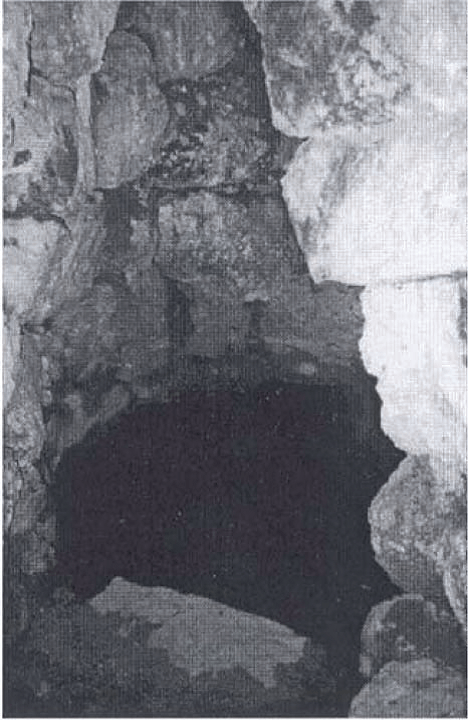
(Photo: Ithaca “School of Homer”, the underground well: the three-dimensional corbelled vault)
Dams
I will mention three characteristic cases of masonry dams used for three different purposes.
(a) A large artificial lake (30 × 100 m) was created just outside the city walls of Mycenae, by means of a masonry dam constructed at an appropriate point of Chavos torrent. An efficient water-tight construction technique was used.
(b) An artificial waterfall was gradually constructed in Alyzeia (Acarnania) west-central Greece, apparently for fleece-washing in a region of intensive cattle-raising (actual Varnaka torrent).
(c) A torrent deviation (still in use today) was constructed in order to protect Tiryns from very destructive floods, which were archaeologically identified. A masonry (clay infilled) dam was erected across the deep river-bed of Tiryns-torrent. A 1500 m long channel was dug in order to convey the torrent waters to the riverbed of another torrent (the actual Aghios Adrianos torrent) 3.0 km away from the Mycenaean city of Tiryns.
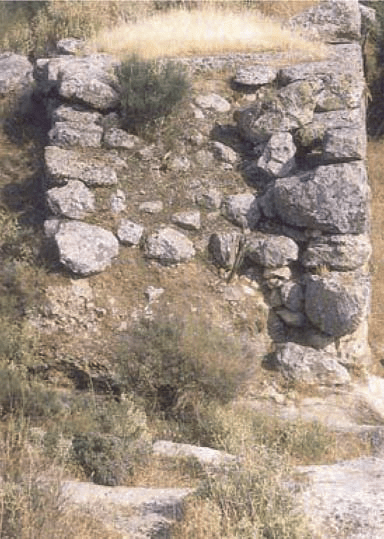
(Photo: Partial view of the Chavos dam)

(Photo: Alyzeia dam)
And this brings us to the other glorious chapter of Mycenaean engineering, flood control that is.
Flood Control and Land-Reclamation Works
During that period, agriculture was the main wealth* of Greek regions – whereas only a small part of soil was cultivable. Besides, most of this cultivable soil was located in closed valleys, flooded almost every year. Flood-control and land reclamation was therefore of a paramount importance for Mycenaean peoples. The advanced hydraulic technology they developed since the middle of the 2nd millennium BCE, is very impressive by its rationality, the large scale of its applications, as well as by its efficiency. Based on the examples of such flood-control works executed in Pheneos, Tiryns, Thisbe and Kopais, one may describe their basic characteristics as follows.
First solution: The waters of the flooding torrent are contained in an artificial lake produced by means of an earth dam, covered by a protective layer of masonry. During summertime, these waters are used for irrigation through a system of small channels; this was the case e.g. of the Arcadian Orchomenos (Pausanias 8.23.2), as well as later on of Mantineia (Thukydides, 5.65). The pertinent dams (containing a clay core) had a height of 3.00 m and they were some hundred or occasionally some thousand meters long.
Second solution: When such an artificial lake was not sufficient (or perhaps was not feasible at all), another solution was followed. First, the torrent is deviated outside the cultivated lands by means of an appropriate large channel. Secondly, this channel is extended towards the perimeter of the valley, close to the surrounding hills, so that the outflow of water be facilitated through existing cesspits in the karstic lime stones of these hills. The internal high fill forming this channel (to the side of the valley) has a width of 20 to 30 m and is covered by an appropriate masonry, protecting the fill against erosion. In this category of solutions belong the marvelous works of the second drainage system of Kopais, during the 14th and the 13th century BCE.
(Read NovoScriptorium’s article on this: https://novoscriptorium.com/2019/03/04/13th-century-bc-myceneans-the-first-hydraulic-civilization-of-europe-mans-most-ancient-attempt-to-control-an-aquatic-environment-using-hydraulic-works/)
In the same context, it is worth noting another category of flood-control Mycenaeans works to protect the ground of Olympia, where the equestrian Games used to take place. That piece of land was eroded both by the river Alpheios and its tributary Kladeos, near the area of their intersection. The works consisted of two major components:
(i) a 500 m long regulatory wall along the east river-bank of Kladeos; the wall containing a core (made of clay and small stones) and masonry covered sides (made of 0.70 m large stones), had a cross-section of 3 × 3 m; and
(ii) a large fill along the north river-bank of Alpheios (see also Pausanias, Hλιακά, 20/15). The area included in the corner of these two protective works, was subsequently infilled, and is still kept intact up to our days.
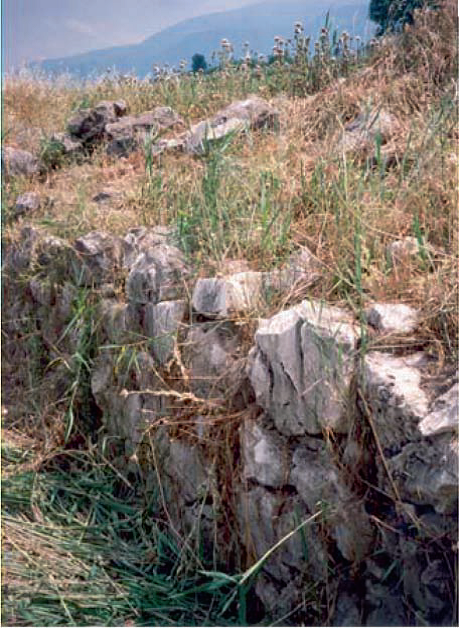
(Photo: Masonry cover of the Mycenaean hill shaping the inner side of the channel)
Building Technology and Bridges
Similar in scale and efficiency are the Mycenaean structural works. The 13th century BCE is the period of the explosive expansion of Achaeans and, at the same time, the period of the large vaulted structures in Greece, Asia Minor and Crete. The Mycenaean corbelled vault, in use earlier than 1600 BCE, is a masterpiece of Mechanics and a daring technique to cover large spans of clear openings up to 13 and 15 m. Mankind would subsequently need another 1500 years to be able to reach such large spans.
All Mycenaean cities were protected by 3 m up to 10 m thick walls; within their width, several arched passages were contained leading to the storehouses (like in the case of Tiryns) or occasionally to subterranean water houses (as in Mycenae). On the other hand, the Mycenaean building technology was successfully following the traditional antiseismic techniques of “timber reinforced masonry”. In less monumental structures however, another traditional material was used, namely adobe, made with appropriately selected low plasticity clay, special sands and “high bond” twigers (2 mm in diameter), as fiber reinforcement; possibly, a small percentage of burnt lime was added.
This material shows a compressive strength as high as 3.0 to 5.0 MPa, whereas no evidence of fire or other thermal treatment was present in the examined samples. All houses of the Mycenaean period contained a complete sewage system – a feature not quite used in medieval times in Europe.
On the other hand, the extensive road network of the Mycenaean times, necessitated several bridges. Those relatively peaceful times allowed for some of these bridges to be permanent (i.e. stone bridges instead of timber). In only the area of Argolis, the remnants of 25 such bridges were found; they were made with the corbel system, covering spans however lower than 2.5 m. Finally, it is worth noting that in the Mycenaean tablets (inscriptions in linear B Greek) several technical professions are mentioned, such as δρύτoμoς (woodcutter), τέκτων (carpenter), ναυδόμoς (shipbuilder), θρoνoυργός (cabinet maker), χαλκήες (coppersmith), τoιχoδόμoς (mason) and the like. And it is remarkable that, at least in one case, a woman was responsible for a team of builders.
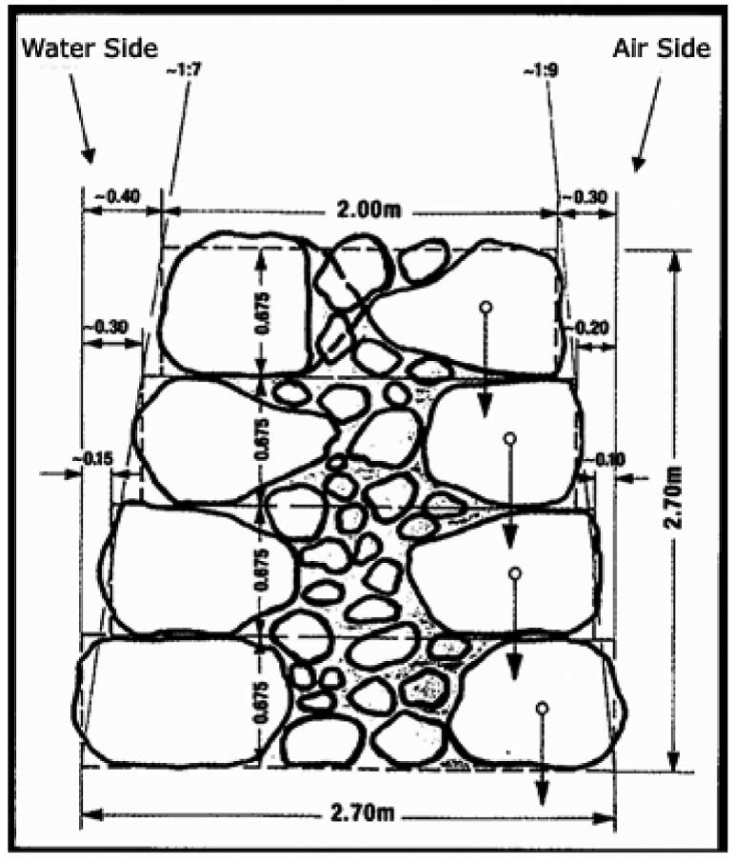
(Photo: Cross-section of the wall causing deviation of ancient Kladeos torrent)
Metallurgy
Silver mining and metal-technique in Lavrion (south Attica) started around 2500 BCE.
(Read an article on this: https://novoscriptorium.com/2018/06/08/some-5000-years-ago-silver-mining-on-the-shores-of-the-aegean-sea/)
“The proof of mining exploitation during the Early Bronze Age” in the Mycenaean acropolis of Velatouri (Lavrion) is given by Spitaels in terms of
(i) traces of working stone tools on the base of ore-bearing veins, and
(ii) of archeological content of the fillings of the floor of the mining gallery, next to the ancient Mycenaean theater of Thorikos.
Such silver mining activities in Thorikos (around 2500 BCE) were accompanied by silver production activities in the broader area of South Eastern Attica, as it is clearly demonstrated by Kakavoyanni et al.: a cupellation workshop was excavated at Lambrika, and hundreds of litharge fragments were recovered, presenting regular shapes of small shallow bowls bearing ten hemispherical cavities on their bottom surface – a proof of the process for silver separation from argentiferous lead.
Thus, a complete evidence is now available for that very early silver-production in Lavrion; much earlier than the litharge fragments found by Servais, on the floor of a Mycenaean house, dated 1350 BCE or those mentioned by Konofagos [11, p. 69] in the island of Kea, dated 1500 BCE.
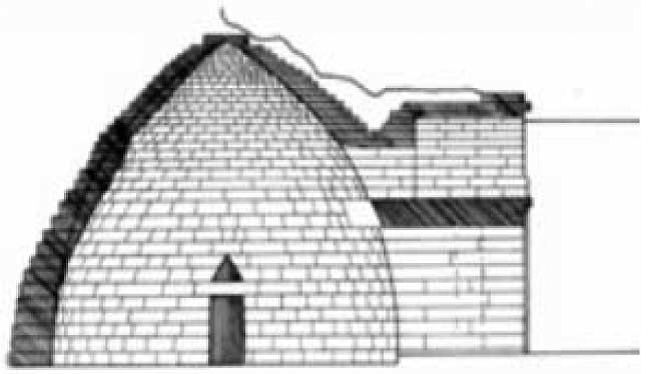
(Photo: Buried Mycenaean corbelled vault)
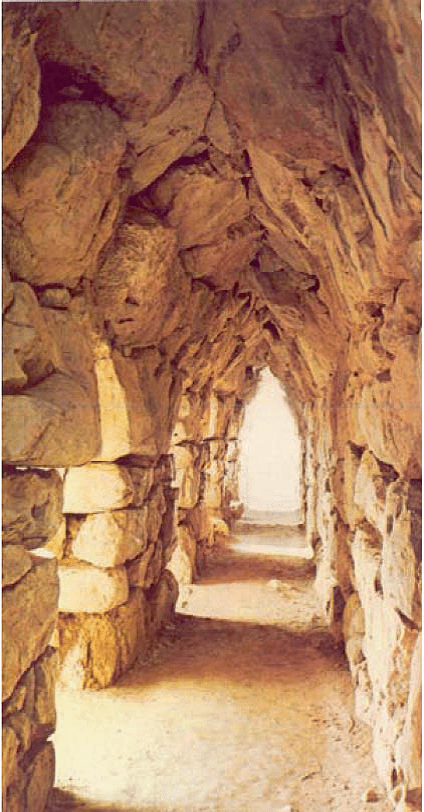
[Photo: Arched passage within the width of city wall (Tiryns)]
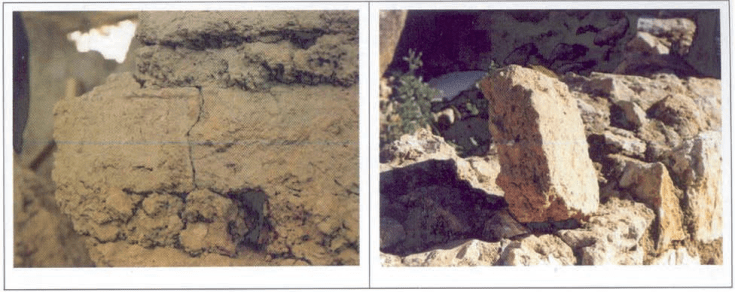
(Photo: Adobe wall in Mycenae. A mud brick is also shown; its resistance is remarkably high)
With such a rich mining and metallurgical background, the Mycenaeans should be in a rather favourable condition to embark in iron metallurgy and iron works too. Nevertheless, probably, before the 12th century BCE only meteoritic iron was used (although Varoufakis has shown that non-meteoritic iron objects existed in the Mycenaean world since the 14th century BCE). Several, iron objects were also imported during the 14th century. After the defeat of the Hittites (beginning of the 12th century), their rather recent innovation of steel production (which was kept secret up to that moment) was apparently propagated to the entire east-Meditarranean world “where steel technology was completely established up to 1100 BCE”.
Varoufakis does not exclude early smelting of local Mycenaean iron ores. After all, the results of recent Swedish investigations in Southern Peloponnesus have shown that:
(i) evidence of metal working since the Bronze Age was found in Asine, and
(ii) in the Early Iron Age bloomery iron was produced and forging took place in Asine.
On the other hand, independently of the origin of the new materials, Mycenaeans smithworkers and metal art technicians were famous for their skills throughout Central and Eastern Mediterranean [7, p. 325].
Shipbuilding
The short presentation of this topic follows the views of Basch. Eastern Mediterranean was always a region of intensive naval activity; all peoples around it had developed the necessary naval technology. After the pirogues of the Neolithic period, a considerable development was observed in the Cyclades where a sophisticated ship (the “Syros”-type ship) was used during the Early Helladic Age (2800– 2200 BCE) (see Figures below).


Its asymmetric longitudinal section and its rather angular shape insinuate distinct functions at various parts of the ship. A remarkable broad use of this ship in the Aegean Sea (from Boeotia, down to Crete) and for a long period, shows its success and popularity. A considerable development of this ship was achieved in Cyclades through centuries. Thus, finally, up to the Mycenaean times [19, p. 148], the following important modifications were introduced to the Syros-type primitive ship:
(i) smoothening of angles,
(ii) quasi-vertical prow,
(iii) further development of the ram, as a prolongation of the keel,
(iv) high stern (with a curved stern-post),
(v) long steering oar,
(vi) considerable lengthening of the ship, to accommodate 25 rowers on each side.
This early πεντηκόντoρoς (pentecontoros, i.e. a 50-rower ship) will prevail in the Mycenaean world, from Boeotia to Messenia and to Crete, for centuries, and will be an extremely powerful means both for peace and war.
*NovoScriptorium: Our reader already knows from previous articles that this is not the case. It doesn’t have to do at all with ‘imagination’ here. It is stated clearly in ancient Greek texts that the ‘gods’ have been human beings of older times (and of many different eras, too) and of great achievements. ‘Mythology’, as we have repeatedly explained, was considered by the ancient Greeks themselves as ‘History of old’. Aristotle, for instance, considered Mythology as ‘History of the Greeks before the Cataclysm‘. So, what is written in the Homeric Epics about the ‘gods’ partially represents realities and facts of ‘their times’, whenever that was. The problem is that modern thinkers and scientists are not willing to accept the possibility that Civilization on Earth could have reached ‘technological hights’ equivalent to ours much earlier in Time. We urge here for some Logic; is there anyone out there who really believes that the ancients (not only the Greeks) would describe advanced Technological achievements (most of them, materialized in our times), some times in detail, out of their imagination? in, supposed, pre-Historic times? And another remark from the study of ‘Mythology’: the ‘gods’ are NOT performing any ‘miracles’! They don’t have – or to be 100% exact, they hardly ever appear to have- super-natural powers, powers that ‘overcome the natural laws’. Almost all their great deeds are performed with the use of ‘technological equipement’! Especially in the Homeric Epics, this is more than clear quite a few times. And, for us, another clear indication of what ‘Mythology’ and the ‘gods’ were for the Greeks who wrote the stories. Of course, researchers, scholars and scientists can choose to remain blind on these facts.
As for the statement “agriculture was the main wealth of Greek regions“, even though it is not substantially wrong, we have to add that everywhere in Greek Mythology, especially in the Homeric Epics, gold -and other metals and luxuries- appear multiple times. Trade, massive Trade, also appears multiple times in the texts. The description of several Homeric cities, in Mycenean Greece, convince us of the great wealth they must have had. So, to claim that the Mycenean society was an ‘agricultural’ one is rather a downgrading of its real condition. Slowly but convincingly, archeological excavations come to support the realities described by Homer on every aspect of the Mycenean civilization.
Research-Selection-Comments: Philaretus Homerides
